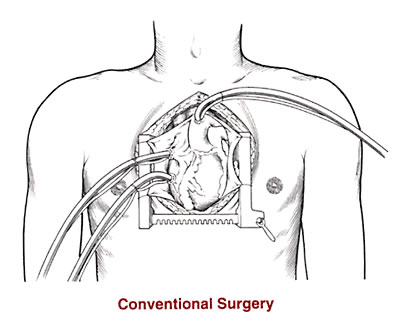Minimally Invasive Heart Surgery
The heart is a remarkable and usually quite robust piece of biomechanical machinery, beating over 100,000 times a day, every day. For all our cleverness and technology, we can't make anything to come close to it. Whilst nature has done it's best to provide useful spares for many critical organs (2 kidneys, 2 lungs etc) we only have one heart, hence it is placed in the most well protected area of our body, behind a solid wall of ribs and muscle.
For most of the history of heart surgery, getting access required exposure of the heart and its vessels through a procedure called a median sternotomy (dividing the breastbone).

Traditionally, the process of getting access to the heart has been an invasive element of surgery. More recently, other approaches have been developed to approach the heart which are called 'minimally invasive'. These allow access to the heart through smaller incisions which are less traumatic and more cosmetic. They can lead to less pain and earlier discharge home. It is even possible to access valves of the heart through veins and arteries. Modern heart surgery is a lot less dramatic affair than it was just a few years ago. Patients are often back on their feet and return to normal life in a matter of days.
Minimally Invasive Aortic Valve Surgery
Here, a 3-4 cm incision is made in the middle of the chest (instead of 7-8 cm) and the breast bone is then opened partially (not completely) to access the heart and the aortic valve. This renders the breast bone more stable with less pain and earlier discharge.
Minimal Invasive Mitral Valve Repair
Here the surgeon accesses the mitral valve via a small cut on the right side of the chest (sometimes referred to as a mini-thoracotomy). A long, thin tube (thoracoscope) containing a tiny high-definition video camera is inserted to look inside the chest. The surgeon can then repair your heart valve using long instruments inserted through small incisions between your ribs. The result is less pain and earlier discharge.

